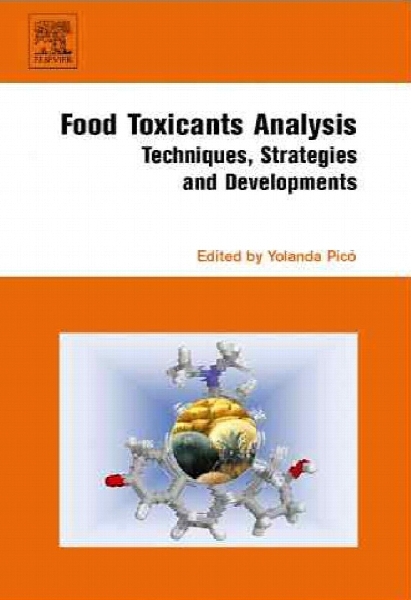Food toxicants analysis : techniques, strategies, and developments
- نوع فایل : کتاب
- زبان : انگلیسی
- مؤلف : Yolanda Picó
- ناشر : Amsterdam ; Boston : Elsevier
- چاپ و سال / کشور: 2007
- شابک / ISBN : 9780444528438
Description
Part 1: Regulations -- 1. The international regulation of chemical toxicants in food: Codex Alimentarius (M. Varadi). -- 2. Different legislation on toxicants in foodstuffs (P. Paulsen <IT>et al</IT>.). -- Part 2. Risk and Quality Assurance -- 3. Risk analysis process (J. Bridges, O. Bridges). -- 4. Quality assurance in toxicants analysis (R. Wood). -- Part 3. Molecular Biology Techniques -- 5. Immunoassays (N.A. Lee, I.R. Kennedy). -- 6. Polymerase chain reaction (PCR)(N. Marmiroli, E. Maestri). -- 7. Analysis of food allergens. Practical applications (A.J. Van Hengel <IT>et al</IT>.). -- 8. Sampling, detection, identification and quantification of genetically modified microorganisms (GMOs)(A. Holst-Jensen). -- Part 4. Screening and Chromatographic Methods -- 9. Extraction procedures (S. Boglialli <IT>et al</IT>.). -- 10. Clean-up and fractionation methods (D.J. Fletouris). -- 11. Automated clean-up techniques (H.G.J. Mol). -- -- 12. Gas chromatography-mass spectrometry (GC-MS) (J. Haj & scaron;lová, T. & Ccaron;ajka). -- 13. Liquid chromatography with conventional detection (M. Rokka <IT>et al</IT>.). -- 14. Liquid chromatography-mass spectrometry (LC-MS) (C. Blasco, Y. Picó). -- 15. Capillary electrophoresis (A. Fekete, P. Schmitt-Koppling). -- 16. Sensors, biosensors and MIP based sensors (M. la Farré, D. Barceló). -- 17. Atomic absorption spectroscopy (S. Akman <IT>et al</IT>.). -- 18. Electrochemical stripping analysis of trace and ultra-trace concentrations of toxics metals and metalloids in foods and beverages (S.B. Adeloju). -- 19. Inductively coupled plasma-mass spectrometry (ICP-MS)(F. Cubadda).
eBook : Document : English : 1st edView all editions and formats
Summary:
Food Toxicants Analysis covers different aspects from the field of analytical food toxicology including emerging analytical techniques and applications to detect food allergens, genetically modified organisms, and novel ingredients (including those of functional foods). Focus will be on natural toxins in food plants and animals, cancer modulating substances, microbial toxins in foods (algal, fungal, and bacterial) and all groups of contaminants (i.e., pesticides), persistent organic pollutants, metals, packaging materials, hormones and animal drug residues. The first section describes the current status of the regulatory framework, including the key principles of the EU food law, food safety, and the main mechanisms of enforcement. The second section addresses validation and quality assurance in food toxicants analysis and comprises a general discussion on the use of risk analysis in establishing priorities, the selection and quality control of available analytical techniques. The third section addresses new issues in food toxicant analysis including food allergens and genetically modified organisms (GMOs). The fourth section covers the analysis of organic food toxicants. * step-by-step guide to the use of food analysis techniques * eighteen chapters covering emerging fields in food toxicants analysis * assesses the latest techniques in the field of inorganic analysis.
Summary:
Food Toxicants Analysis covers different aspects from the field of analytical food toxicology including emerging analytical techniques and applications to detect food allergens, genetically modified organisms, and novel ingredients (including those of functional foods). Focus will be on natural toxins in food plants and animals, cancer modulating substances, microbial toxins in foods (algal, fungal, and bacterial) and all groups of contaminants (i.e., pesticides), persistent organic pollutants, metals, packaging materials, hormones and animal drug residues. The first section describes the current status of the regulatory framework, including the key principles of the EU food law, food safety, and the main mechanisms of enforcement. The second section addresses validation and quality assurance in food toxicants analysis and comprises a general discussion on the use of risk analysis in establishing priorities, the selection and quality control of available analytical techniques. The third section addresses new issues in food toxicant analysis including food allergens and genetically modified organisms (GMOs). The fourth section covers the analysis of organic food toxicants. * step-by-step guide to the use of food analysis techniques * eighteen chapters covering emerging fields in food toxicants analysis * assesses the latest techniques in the field of inorganic analysis.


